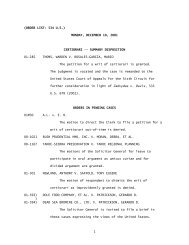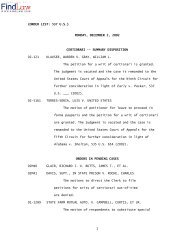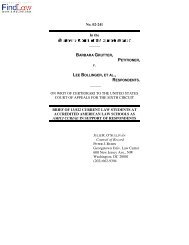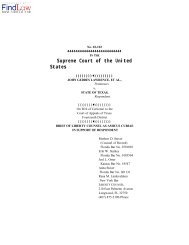No. 01-1757 Stogner v. California - FindLaw: Supreme Court Center
No. 01-1757 Stogner v. California - FindLaw: Supreme Court Center
No. 01-1757 Stogner v. California - FindLaw: Supreme Court Center
You also want an ePaper? Increase the reach of your titles
YUMPU automatically turns print PDFs into web optimized ePapers that Google loves.
32<br />
II. A RETROACTIVE CHANGE IN THE STATUTE<br />
OF LIMITATIONS THAT REVIVES A PREVI-<br />
OUSLY-EXPIRED CAUSE OF ACTION IN A<br />
CRIMINAL CASE DOES NOT, ON ITS FACE,<br />
VIOLATE THE DUE PROCESS CLAUSE<br />
A. The Ex Post Facto Clause, <strong>No</strong>t the More Generalized<br />
<strong>No</strong>tion of Substantive Due Process,<br />
Governs the Constitutional Inquiry<br />
The Due Process Clause of the Fourteenth Amendment<br />
contains a substantive component, sometimes<br />
referred to as “substantive due process,” which bars<br />
certain arbitrary government actions regardless of the<br />
procedures used to implement them. Daniels v. Williams,<br />
474 U.S. 327, 337 (1986). Petitioner, referencing a “fundamental<br />
right of liberty” (Pet. Br. 33) and “the substantive<br />
nature of the right” (Pet. Br. 40), asks this <strong>Court</strong> to find<br />
that a retroactive change in the statute of limitations in a<br />
criminal case violates substantive due process. This<br />
contention fails at the threshold because the Due Process<br />
Clause cannot be read to provide greater protections<br />
against ex post facto laws than the Ex Post Facto Clause<br />
itself.<br />
When a particular constitutional amendment “provides<br />
an explicit textual source of constitutional protection”<br />
against a particular sort of government behavior,<br />
“that Amendment, not the more generalized notion of<br />
‘substantive due process,’ must be the guide for analyzing<br />
these claims.” Albright v. Oliver, 510 U.S. 266, 273 (1994)<br />
(quoting Graham v. Connor, 490 U.S. 386, 395 (1989)). The<br />
<strong>Court</strong> recently reiterated this principle in Sattazahn v.<br />
Pennsylvania, 537 U.S. ___ (2003), in which it stated that<br />
“[a]t bottom, petitioner’s due-process claim is nothing<br />
more than his double-jeopardy claim in different clothing,”






